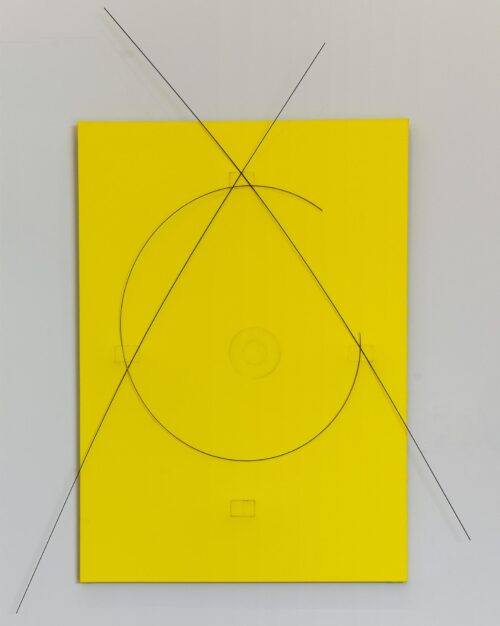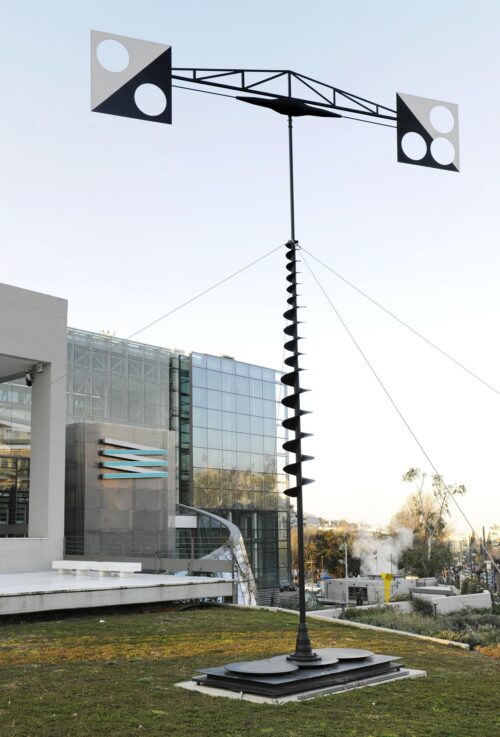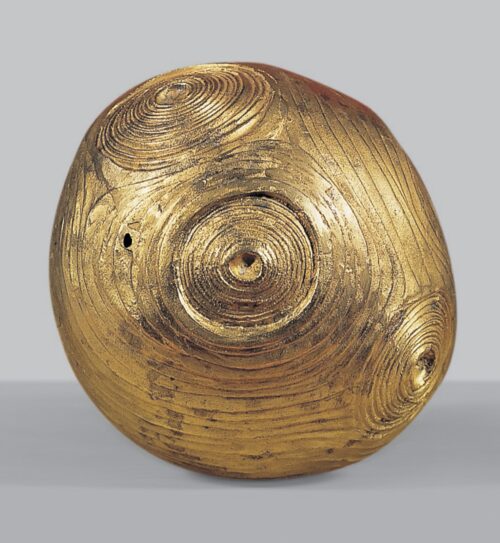
Takis (Panayiotis Vassilakis) (1925)
Magnetic wall
Born into a large family, he experienced a rough childhood and adolescence, marked by hunger and imprisonment during the German Occupation.
His long artistic career began in 1946, when he made his first sculptures in plaster. Cycladic and archaic statuary as well as his encounter with Alberto Giacometti’s sculpture inspired him to create a series of wire, cloth and plaster figures.
In 1954, he settled in Paris. During the same year, he began the “Signals” series – kinetic sculptures producing musical sounds as they chime in the wind. In 1959, he showed at Iris Clert Gallery his first “Tele-Magnetic Sculptures”, making use of electromagnetic fields and thus offering in tangible form the invisible energy ever-present in the universe. The light and motion in every manifestation – mechanical, electromechanical, thermal, magnetic, hydrodynamic – have also been at the core of his work. Coming soon after, “Tele-Lights” were based on electromagnetic principles. In fact, during a performance in Iris Clert Gallery in 1960, thanks to a magnetic device made by the artist, the poet Sinclair Beiles was suspended several feet above ground, reciting the “Magnetic Manifesto”. During the same year began Takis’s long partnership with Alexander Iolas, with the artist’s first solo exhibition in New York held at the latter’s gallery.
During his stay in Paris, he met and hung out with the American writers of the Beat Generation; in New York, he met Marcel Duchamp. His autobiography (“Estafilades”) was published in 1961.
In 1968-1969, on MIT fellowship, he created his first “Hydro-magnetic Sculptures”. His “Musical Sculptures” had already appeared in 1965, in which musical sound is produced by random magnet movement. His explorations along these lines continued with the production of musical rooms as well as music and choreography happenings, culminating in the adaptation in 1992 of the aqueduct at the city of Beauvais into a huge musical sculpture. In 1974, he began producing casts of male and female bodies – the first in a series of erotic sculptures.
In his long creative activity, Takis has had major solo exhibitions, including retrospectives at the Centre National d’Art Contemporain (1972) and the Galerie Nationale du Jeu de Paume (1993); the latter was also held at the “Factory” building of the Athens School of Fine Arts (1994). In 1999, he first presented his Photovoltaic Sculptures” in “Takis Millennium”. He has also participated in major group events, including the “Documenta” in Kassel (1977) and “The Century of Kafka” at the Centre Georges Pompidou (1984); he also represented Greece at the Venice Biennale in 1995. In 1985, he received the first prize at the Paris Biennale and in 1988 the French Grand Prix National de Sculpture.
The theatre and the cinema also attracted his interest as an artist. Thus, in 1973, he designed the set for the ballet “Eleusis” at the Netherlands National Festival and in 1983 the set for “Electra” by Sophocles at the ancient theatre of Epidaurus. He also collaborated with director Costa Gavras in the soundtrack of the film “Section Speciale”.
Takis’s works are to be found in most contemporary art museums and private collections around the world. In 1987, the French government commissioned a series of Signals, which were installed at La Defense, Paris; in 1988, he produced a “Signal” for the Olympic Sculpture Park in Seoul; in 1990, “Light Signals” were installed at the Grande Arche at La Defense; in 1993, he designed a metro station in Toulouse. In the early 1990’s, Takis settled in Greece and in 1993 established the Centre for the Arts and Sciences at Gerovouno, Attica. In 2000, his “Homage to Apollo” was installed in Delphi – an enormous kinetic sculpture operating on photovoltaic energy and his largest public site sculpture in Greece.
An unswervingly self-taught artist, Takis is a rare inventor and among the artists who regenerated sculpture. Rejecting the art of realistic figuration as well as traditional techniques, he has supported his artistic expression through constant research, study and experimentation in the functional use of natural laws, combining science and art in his strife to initiate the viewer into the essence of the universe.

Magnetic wall

Aeolian Signal, 1984

Interior Space, 1957

We use cookies to make our site work properly, to personalize content and ads, to provide social media features and to analyze our traffic. We also share information about how you use our site with our social media, advertising and analytics partners. Read the Cookies Policy.
These cookies are necessary for the website to function and cannot be switched off in our systems. They are usually only set in response to actions made by you which amount to a request for services, such as setting your privacy preferences, logging in or filling in forms. You can set your browser to block or alert you about these cookies, but some parts of the site will not then work. These cookies do not store any personally identifiable information.
If you disable this cookie, we will not be able to save your preferences. This means that every time you visit this website you will need to enable or disable cookies again.
These cookies tell us about how you use the site and they help us to make it better. For example these cookies count the number of visitors to our website and see how visitors move around when they are using it. This helps us to improve the way our site works, for example, by ensuring that users find what they are looking for easily. Our website uses Google Analytics for statistics reporting.
Please enable Strictly Necessary Cookies first so that we can save your preferences!